STS-26 (original) (raw)

Home - Search - Browse - Alphabetic Index: 0- 1- 2- 3- 4- 5- 6- 7- 8- 9
A- B- C- D- E- F- G- H- I- J- K- L- M- N- O- P- Q- R- S- T- U- V- W- X- Y- Z
STS-26
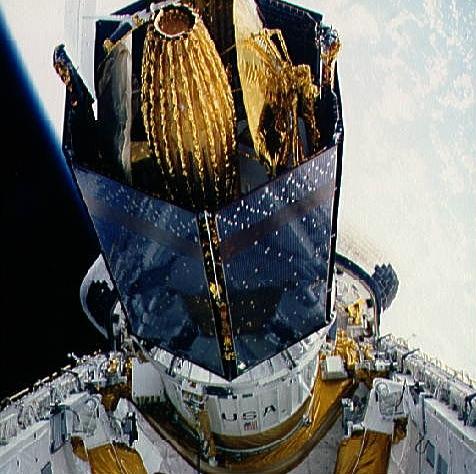
STS-26
STS-26 Discovery, Orbiter Vehicle (OV) 103, IUS / TDRS-C deployment
Credit: NASA
First shuttle reflight after Challenger disaster. Deployed TDRS 3.
AKA: Discovery. Launched: 1988-09-29. Returned: 1988-10-03. Number crew: 5 . Duration: 4.04 days.
The crew was announced by George Abbey to the astronauts on 9 January 1987. Nelson's selection as commander angered the other astronauts. He had made the last flight before the shuttle, and instead of working on returning the shuttle to flight during the long stand-down, had taken a sabbatical and taken management courses at the University of Washington. It was seen as another example of Abbey governing through intentional chaos, using (in the words of the NASA psychiatrist) "inconsistency, ambiguity, silence, evasion" as part of "studied unpredictability".
Return-to-flight mission after the Challenger disaster. Although receiving great press attention, the mission itself was pretty limited, involving only release of a TDRS satellite - leading other astronauts to dub it 'The Quiche Mission'. The other astronauts came to resent the publicity being given to the "brave crew" of Hauck's STS-26 mission, who they felt they had broken the second astronaut commandment, "Thou shalt not bask in glory".
NASA was upset when the press ignored the 'glorious' footage of the TDRS deployment on STS-26 and instead insisted on running the in-cabin 'horsing around' stuff, which they felt made the space program look like a multi-billion dollar junket for spoiled astronauts. They would sharply restrict release of such footage in the future.
Payloads: Deploy IUS (lnertial Upper Stage) with Tracking and Data Relay Satellite (TDRS)-C. 3M's Physical Vapor Transport Organics Solids 2 experiment (PVTOS), Automated Directional Solidification Furnace (ADSF), Infrared Communications Flight Experiment (lRCFE), Protein Crystal Growth Il (PCG), Isoelectric Focusing (ISF)-2, Phase Partitioning Experiment (PPE), Aggregation of Red Blood Cells (ARC)-2, Mesoscale Lightning Experiment (MLE)-1, Earth Limb Radiance (ELRAD), Orbiter Experiments (OEX), Autonomous Supporting Instrumentation System (OASIS)-I, two Shuttle Student Involvement Project (SSIP) experiments. Orbits of Earth: 63. Distance traveled: 2,703,697 km. Orbiter Liftoff Mass: 115,487 kg. Orbiter Mass at Landing: 88,078 kg. Payload to Orbit: 21,082 kg. Payload Returned: 4,066 kg. Landed at: Runway 17 dry lake bed at Edwards Air Force Base, . Landing Speed: 346 kph. Touchdown miss distance: 761 m. Landing Rollout: 2,271 m.
NASA Official Mission Narrative
Mission Name: STS-26 (26)
DISCOVERY (7)
Pad 39-B (7)
26th Shuttle mission
7th Flight OV-103
Crew:
Frederick H. Hauck (3), Commander
Richard O. Covey (2), Pilot
John M. Lounge (2), Mission Specialist 1
George D. Nelson (3), Mission Specialist 2
David C. Hilmers (2), Mission Specialist 3
Milestones:
OPF - Oct. 30, 1986
VAB - June 21, 1988
PAD - July 4, 1988
Payload:
TDRS-C,PVTOS,PCG,IRCFE,ARC,IFE,MLE,PPE,ELRAD,ASDF,SSIP(x2),OASIS-I
Mission Objectives:
Launch:
September 29, 1988,11:37:00 a.m. EDT. Launch delayed one hour, 38 minutes to replace fuses in cooling system of two of crew's flight pressure suits, and due to lighter than expected upper atmospheric winds. Suit repairs successful and countdown continued after waiver of wind condition constraint. Launch Weight: 254,606 lbs.
Orbit:
Altitude: 203nm
Inclination: 28.5degrees
Orbits: 64
Duration: Four days, one hour, zero minutes, 11 seconds.
Distance: 1,680,000 miles
Hardware:
SRB: BI-029
SRM: 360L001
ET : 28/LWT-21
MLP : 2
SSME-1: SN-2019
SSME-2: SN-2022
SSME-3: SN-2028
Landing:
October 3, 1988, 9:37:11 a.m. PDT, Runway 17, Edwards Air Force Base, Calif. Rollout distance: 7,451 feet. Rollout time: 49 seconds. Orbiter returned to KSC Oct. 8,1988. Landing Weight: 194,184 lbs.
Mission Highlights:
Primary payload, NASA Tracking and Data Relay Satellite-3 (TDRS-3) attached to an Inertial Upper Stage (IUS), became second TDRS deployed. After deployment, IUS propelled satellite to geosynchronous orbit. Secondary payloads: Physical Vapor Transport of Organic Solids (PVTOS); Protein Crystal Growth (PCG); Infrared Communications Flight Experiment (IRCFE); Aggregation of Red Blood Cells (ARC); Isoelectric Focusing Experiment (IFE); Mesoscale Lightning Experiment (MLE); Phase Partitioning Experiment (PPE); Earth-Limb Radiance Experiment (ELRAD); Automated Directional Solidification Furnace (ADSF) and two Shuttle Student Involvement Program (SSIP) experiments. Orbiter Experiments Autonomous Supporting Instrumentation System-I (OASIS-I) recorded variety of environmental measurements during various inflight phases of orbiter. Ku-band antenna in payload bay deployed; however, dish antenna command and actual telemetry did not correspond. Also, orbiter cabin Flash Evaporator System iced up, raising crew cabin temperature to mid-80s.
More at: STS-26.
Family: Manned spaceflight. People: Covey, Hauck, Hilmers, Lounge, Nelson. Country: USA. Spacecraft: Discovery. Projects: STS. Launch Sites: Cape Canaveral. Agency: NASA, NASA Houston. Bibliography: 4457.
Photo Gallery
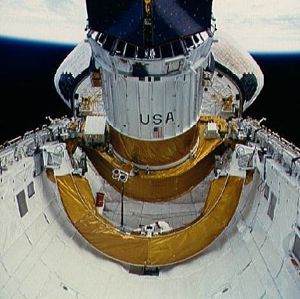 |
STS-26STS-26 Discovery, Orbiter Vehicle (OV) 103, IUS / TDRS-C deploymentCredit: NASA |
|---|
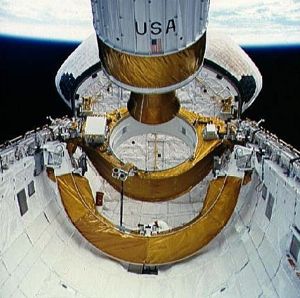 |
STS-26STS-26 Discovery, Orbiter Vehicle (OV) 103, IUS / TDRS-C deploymentCredit: NASA |
|---|
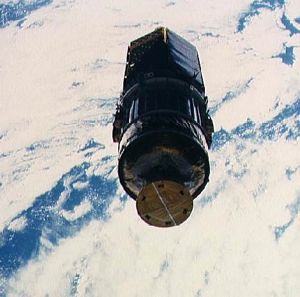 |
STS-26STS-26 Discovery, Orbiter Vehicle (OV) 103, IUS / TDRS-C deploymentCredit: NASA |
|---|
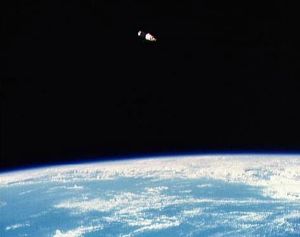 |
STS-26STS-26 Discovery, Orbiter Vehicle (OV) 103, IUS / TDRS-C deploymentCredit: NASA |
|---|
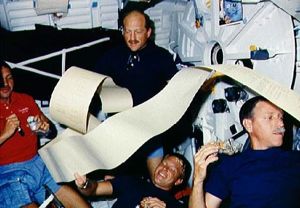 |
STS-26STS-26 crewmembers eat on middeck as TAGS printout drifts among themCredit: NASA |
|---|
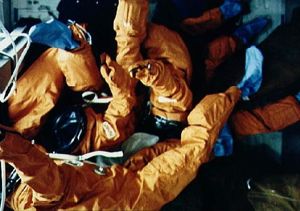 |
STS-26STS-26 launch and entry suits (LESs) free float on OV-103's middeckCredit: NASA |
|---|
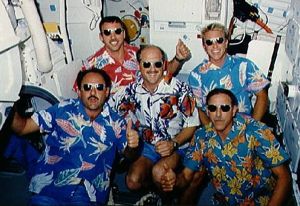 |
STS-26STS-26 crewmembers in Hawaiian shirts and sunglasses pose for group portraitCredit: NASA |
|---|
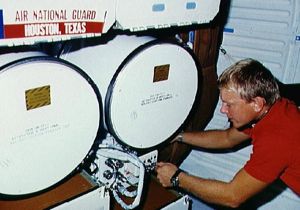 |
STS-26STS-26 MS Nelson adjusts ADSF power cable on Discovery's middeckCredit: NASA |
|---|
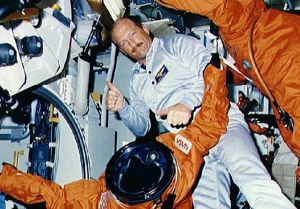 |
STS-26STS-26 Commander Hauck with launch and entry suits (LESs) on OV-103's middeckCredit: NASA |
|---|
1988 September 29 - . 15:37 GMT - . Launch Site: Cape Canaveral. Launch Complex: Cape Canaveral LC39B. Launch Platform: MLP2. LV Family: Shuttle. Launch Vehicle: Space Shuttle.
- STS-26 - . Call Sign: Discovery. Crew: Covey, Hauck, Hilmers, Lounge, Nelson. Payload: Discovery F07 / PDP. Mass: 21,082 kg (46,477 lb). Nation: USA. Related Persons: Covey, Hauck, Hilmers, Lounge, Nelson. Agency: NASA Houston. Program: STS. Class: Manned. Type: Manned spaceplane. Flight: STS-26. Spacecraft Bus: Shuttle. Spacecraft: Discovery. Duration: 4.04 days. Decay Date: 1988-10-03 . USAF Sat Cat: 19547 . COSPAR: 1988-091A. Apogee: 306 km (190 mi). Perigee: 301 km (187 mi). Inclination: 28.50 deg. Period: 90.60 min.
Manned five crew. First shuttle reflight after Challenger disaster. Deployed TDRS 3. Payloads: Deploy IUS (lnertial Upper Stage) with Tracking and Data Relay Satellite (TDRS)-C. 3M's Physical Vapor Transport Organics Solids 2 experiment (PVTOS), Automated Directional Solidification Furnace (ADSF), Infrared Communi-cations Flight Experiment (lRCFE), Protein Crystal Growth Il (PCG), Isoelectric Focusing (ISF)-2, Phase Partitioning Experiment (PPE), Aggrega-tion of Red Blood Cells (ARC)-2, Mesoscale Lightning Experiment (MLE)-1, Earth Limb Radiance (ELRAD), Orbiter Experiments (OEX), Autonomous Supporting Instrumentation System (OASlS)-I, two Shuttle Student Involvement Project (SSIP) experiments.
1988 September 30 - .
- STS-26 - Wakeup Song: Good Morning Vietnam - . Flight: STS-26.
"Good Morning Vietnam" style - Robin Williams opened with"Gooooooood Morning Discovery!!!"
The original recording produced by Houston area DJ from KKBQ, Mike Cahill, also included original lyrics recorded to the theme music of the TV show"Green Acres". Robin Williams was approached by Cahill about doing the tape. NASA knew nothing of the tape until it was offered as a gift by Cahill. Mike Cahill, writer, producer for KKBQ Radio, Houston and a part-time on-call tour guide at JSC, said he had listened to some wake-up calls a year and a half ago and some of them were,"You know, kind of awful. So what I did was thought gee it would be nice to write, produce and custom design songs for the astronauts. I picked three tunes that were pretty catchy, that were very short and upbeat. Green Acres was the first one. I thought gosh that would be the last thing they'll expect to hear" Pat Mattingly, who works in Mission Control, found out Cahill was doing them and said they were looking for new stuff. She gave a tape to CAPCOM Kathy Sullivan. Mike wrote the lyrics in early 1987. Threw in Discovery because knew it would be next Orbiter to fly. He collaborated with Mark Richardson, the leader of a band named"Eclipse" Mike and Mark worked on putting the music together. Richardson played keyboard, guitars, drum machine. Mike called on Patrick Brennan who used to be with now-defunct group"Popkorn" that played in clubs around Clear Lake to do the vocals. Mike and Mark helped out on the chorus for Green Acres. Green Acres was Mike's favorite."It was as dopey and stupid and corny as I had hoped it would be" He said he wanted to show that NASA people have a sense of humor."It's the closest I'll ever get to going to space"
1988 October 1 - .
- STS-26 - Wakeup Song: I Get Around - . Flight: STS-26. "I Get Around" Parody of Beach Boys with lyrics"We orbit 'round" was provided by radio disc jockey Mike Cahill..
1988 October 2 - .
- STS-26 - Wakeup Song: Harvey Mudd College Claremont Fight Song - . Flight: STS-26.
"Harvey Mudd College Claremont Fight Song" , sung to tune of"Mickey Mouse Club" by eight HMC students with intro by Robin Williams. Harvey Mudd is the alma mater of mission specialist Pinky Nelson. He commented afterwards:"There isn't a dry eye in the house"
1988 October 3 - .
- STS-26 - Wakeup Song: Fun, Fun, Fun.. - . Flight: STS-26. "Fun, Fun, Fun.." Beach Boys parody with original lyrics..
1988 October 3 - .
- Landing of STS-26 - . Return Crew: Covey, Hauck, Hilmers, Lounge, Nelson. Nation: USA. Related Persons: Covey, Hauck, Hilmers, Lounge, Nelson. Program: STS. Flight: STS-26. STS-26 landed at 16:50 GMT. .
Home - Search - Browse - Alphabetic Index: 0- 1- 2- 3- 4- 5- 6- 7- 8- 9
A- B- C- D- E- F- G- H- I- J- K- L- M- N- O- P- Q- R- S- T- U- V- W- X- Y- Z
© 1997-2019 Mark Wade - Contact
© / Conditions for Use